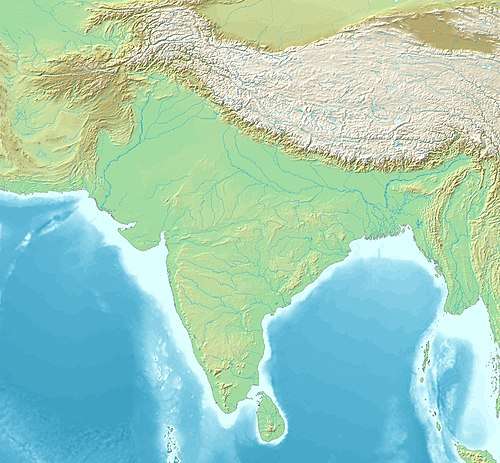Narendraditya Khinkhila
Narendraditya Khinkhila (r.c. 597-633 CE),[1] also called Naranda or Narenda or Deva Shahi Khingila from his coin legends,[1] was one of the last rulers of the Alchon Huns in the area of Gandhara and Kashmir in northwestern India, following their retreat from northern India, during the 6th century CE.[2][3] According to Kalhana's 12th century text Rajatarangini, where is full name Narendraditya Khinkhila is used, he was the son of a king named Gokarna, a follower of Shiva.[3][2] Narendraditya is also known to have consecrated a shrine to Shiva, names Bhutesvara.[1]
| Narendraditya Khinkhila | |
|---|---|
| Ruler of the Alchon Huns | |
 Portrait of Narendraditya Khinkhila, from his coinage.
 Approximate location of Narendraditya Khinkhila's territory | |
| Reign | 530-590 |
| Predecessor | Gokarna |
| Successor | Yudhishthira |
| Alchon Huns (400–670 CE) | |||||||||||||||||||||||||||||||||||||||
|---|---|---|---|---|---|---|---|---|---|---|---|---|---|---|---|---|---|---|---|---|---|---|---|---|---|---|---|---|---|---|---|---|---|---|---|---|---|---|---|
|
|||||||||||||||||||||||||||||||||||||||
The son of Narendraditya was Yudhishthira, who succeeded him as king, and was the last known kings of the Alchon Huns.[2] Yudhishthira ruled 40 years until circa 670 CE, but he was dethroned by Pratapaditya, son of the founder of the Karkoṭa Empire, Durlabhvardhana.[1]
Coinage
_Circa_570-600_CE.jpg) Peshawar region Narendra (Narana) Circa 570-600 CE. Billon Drachm (5.63 gm). Obverse: Crowned bust of king right; Brahmi legend before:
Peshawar region Narendra (Narana) Circa 570-600 CE. Billon Drachm (5.63 gm). Obverse: Crowned bust of king right; Brahmi legend before:


 Coin of Narana-Narendra Circa 540 CE. Circa 540 CE. Æ 22mm "Drachm" (3.75 gm). Crowned head right with diadem and two trident patterns
Coin of Narana-Narendra Circa 540 CE. Circa 540 CE. Æ 22mm "Drachm" (3.75 gm). Crowned head right with diadem and two trident patterns Another coin of Narana-Narendra
Another coin of Narana-Narendra
References
- Dani, Ahmad Hasan; Litvinsky, B. A. (1996). History of Civilizations of Central Asia: The crossroads of civilizations, A.D. 250 to 750. UNESCO. p. 170. ISBN 9789231032110.
- Dani, Ahmad Hasan; Litvinsky, B. A. (1996). History of Civilizations of Central Asia: The crossroads of civilizations, A.D. 250 to 750. UNESCO. p. 169. ISBN 9789231032110.
- Kim, Hyun Jin (2015). The Huns. Routledge. p. 58. ISBN 9781317340911.